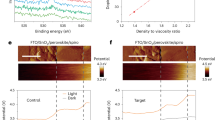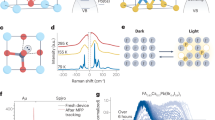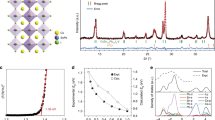Abstract
Solar cells based on metal halide perovskites are one of the most promising photovoltaic technologies1,2,3,4. Over the past few years, the long-term operational stability of such devices has been greatly improved by tuning the composition of the perovskites5,6,7,8,9, optimizing the interfaces within the device structures10,11,12,13, and using new encapsulation techniques14,15. However, further improvements are required in order to deliver a longer-lasting technology. Ion migration in the perovskite active layer—especially under illumination and heat—is arguably the most difficult aspect to mitigate16,17,18. Here we incorporate ionic liquids into the perovskite film and thence into positive–intrinsic–negative photovoltaic devices, increasing the device efficiency and markedly improving the long-term device stability. Specifically, we observe a degradation in performance of only around five per cent for the most stable encapsulated device under continuous simulated full-spectrum sunlight for more than 1,800 hours at 70 to 75 degrees Celsius, and estimate that the time required for the device to drop to eighty per cent of its peak performance is about 5,200 hours. Our demonstration of long-term operational, stable solar cells under intense conditions is a key step towards a reliable perovskite photovoltaic technology.
This is a preview of subscription content, access via your institution
Access options
Access Nature and 54 other Nature Portfolio journals
Get Nature+, our best-value online-access subscription
$29.99 / 30 days
cancel any time
Subscribe to this journal
Receive 51 print issues and online access
$199.00 per year
only $3.90 per issue
Buy this article
- Purchase on Springer Link
- Instant access to full article PDF
Prices may be subject to local taxes which are calculated during checkout




Similar content being viewed by others
Data availability
The data that support the findings of this study are available from the corresponding author upon reasonable request.
References
Lee, M. M., Teuscher, J., Miyasaka, T., Murakami, T. N. & Snaith, H. J. Efficient hybrid solar cells based on meso-superstructured organometal halide perovskites. Science 338, 643–647 (2012).
Burschka, J. et al. Sequential deposition as a route to high-performance perovskite-sensitized solar cells. Nature 499, 316–319 (2013).
Jeon, N. J. et al. Compositional engineering of perovskite materials for high-performance solar cells. Nature 517, 476–480 (2015).
Liu, M., Johnston, M. B. & Snaith, H. J. Efficient planar heterojunction perovskite solar cells by vapour deposition. Nature 501, 395–398 (2013).
Saliba, M. et al. Cesium-containing triple cation perovskite solar cells: improved stability, reproducibility and high efficiency. Energy Environ. Sci. 9, 1989–1997 (2016).
Wang, Z. et al. Efficient ambient-air-stable solar cells with 2D–3D heterostructured butylammonium-caesium-formamidinium lead halide perovskites. Nat. Energy 2, 17135 (2017).
McMeekin, D. P. et al. A mixed-cation lead mixed-halide perovskite absorber for tandem solar cells. Science 351, 151–155 (2016).
Saliba, M. et al. Incorporation of rubidium cations into perovskite solar cells improves photovoltaic performance. Science 354, 206–209 (2016).
Tsai, H. et al. High-efficiency two-dimensional Ruddlesden–Popper perovskite solar cells. Nature 536, 312–316 (2016).
Arora, N. et al. Perovskite solar cells with CuSCN hole extraction layers yield stabilized efficiencies greater than 20%. Science 358, 768–771 (2017).
Chen, W. et al. Efficient and stable large-area perovskite solar cells with inorganic charge extraction layers. Science 350, 944–948 (2015).
Hou, Y. et al. A generic interface to reduce the efficiency-stability-cost gap of perovskite solar cells. Science 358, 1192–1197 (2017).
Christians, J. A. et al. Tailored interfaces of unencapsulated perovskite solar cells for >1,000 hour operational stability. Nat. Energy 3, 68–74 (2018).
Bella, F. et al. Improving efficiency and stability of perovskite solar cells with photocurable fluoropolymers. Science 354, 203–206 (2016).
Cheacharoen, R. et al. Design and understanding of encapsulated perovskite solar cells to withstand temperature cycling. Energy Environ. Sci. 11, 144–150 (2018).
Divitini, G. et al. In situ observation of heat-induced degradation of perovskite solar cells. Nat. Energy 1, 15012 (2016).
Leijtens, T. et al. Mapping electric field-induced switchable poling and structural degradation in hybrid lead halide perovskite thin films. Adv. Energy Mater. 5, 1500962 (2015).
Domanski, K. et al. Migration of cations induces reversible performance losses over day/night cycling in perovskite solar cells. Energy Environ. Sci. 10, 604–613 (2017).
Yang, D. et al. Surface optimization to eliminate hysteresis for record efficiency planar perovskite solar cells. Energy Environ. Sci. 9, 3071–3078 (2016).
Zhang, Y. et al. A strategy to produce high efficiency, high stability perovskite solar cells using functionalized ionic liquid-dopants. Adv. Mater. 29, 1702157 (2017).
Luo, D. et al. Enhanced photovoltage for inverted planar heterojunction perovskite solar cells. Science 360, 1442–1446 (2018).
Nie, W. et al. Critical role of interface and crystallinity on the performance and photostability of perovskite solar cell on nickel oxide. Adv. Mater. 30, 1703879 (2018).
Li, C. et al. Real-time observation of iodide ion migration in methylammonium lead halide perovskites. Small 13, 1701711 (2017).
Li, C., Guerrero, A., Huettner, S. & Bisquert, J. Unravelling the role of vacancies in lead halide perovskite through electrical switching of photoluminescence. Nat. Commun. 9, 5113 (2018).
Bryant, D. et al. Light and oxygen induced degradation limits the operational stability of methylammonium lead triiodide perovskite solar cells. Energy Environ. Sci. 9, 1655–1660 (2016); correction 9, 1850 (2016).
Aristidou, N. et al. Fast oxygen diffusion and iodide defects mediate oxygen-induced degradation of perovskite solar cells. Nat. Commun. 8, 15218 (2017).
Sun, Q. et al. Role of microstructure in oxygen induced photodegradation of methylammonium lead triiodide perovskite films. Adv. Energy Mater. 7, 1700977 (2017).
Kaltenbrunner, M. et al. Flexible high power-per-weight perovskite solar cells with chromium oxide–metal contacts for improved stability in air. Nat. Mater. 14, 1032–1039 (2015).
Ross, J. R. G. Crystalline-silicon reliability lessons for thin-film modules. In Proc. 18th IEEE Photovoltaic Specialists Conference 1114–1020 (1985).
Snaith, H. J. & Hacke, P. Enabling reliability assessments of pre-commercial perovskite photovoltaics with lessons learned from industrial standards. Nat. Energy 3, 459–465 (2018).
Wang, J. T.-W. et al. Efficient perovskite solar cells by metal ion doping. Energy Environ. Sci. 9, 2892–2901 (2016).
Jeon, N. J. et al. Solvent engineering for high-performance inorganic–organic hybrid perovskite solar cells. Nat. Mater. 13, 897–903 (2014).
Bai, S. et al. Reproducible planar heterojunction solar cells based on one-step solution-processed methylammonium lead halide perovskites. Chem. Mater. 29, 462–473 (2017).
Wang, Z. et al. Efficient and air-stable mixed-cation lead mixed-halide perovskite solar cells with n-doped organic electron extraction layers. Adv. Mater. 29, 1604186 (2017).
Mei, A. et al. A hole-conductor-free, fully printable mesoscopic perovskite solar cell with high stability. Science 345, 295–298 (2014).
Shin, S. S. et al. Colloidally prepared La-doped BaSnO3 electrodes for efficient, photostable perovskite solar cells. Science 356, 167–171 (2017).
Tan, H. et al. Efficient and stable solution-processed planar perovskite solar cells via contact passivation. Science 355, 722–726 (2017).
Bush, K. A. et al. 23.6%-efficient monolithic perovskite/silicon tandem solar cells with improved stability. Nat. Energy 2, 17009 (2017).
Acknowledgements
This work was funded in part by the UK Engineering and Physical Sciences Research Council (EPSRC; grants EP/M015254/2 and EP/M024881/1); the European Research Council (ERC) Starting Grant (717026); the Swedish Research Council Vetenskapsrådet (grant 330-2014-6433); the European Commission Marie Skłodowska-Curie action (grant INCA 600398); the Swedish Government Strategic Research Area in Materials Science on Functional Materials at Linköping University (faculty grant SFO-Mat-LiU 2009-00971); and the European Union’s Horizon 2020 research and innovation program under grant agreement 763977 of the PerTPV project. S. Bai is a VINNMER Fellow and Marie Curie Fellow. P.D. and Z.Y. acknowledge support from the China Scholarship Council (CSC). C.L. and S.H acknowledge financial support from the Bavarian State Ministry of Science, Research, and the Arts for the Collaborative Research Network ‘Solar Technologies go Hybrid’ and the German Research Foundation (DFG). M.K. acknowledges support from the Swiss National Science Foundation (grant cr23i2-162828). We thank H. Long, Z. Yan, C. Bao, N. Noel, B. Wenger, J. Ball and O. Inganäs for experimental assistance and discussions.
Reviewer information
Nature thanks Aditya Mohite, Shougen Yin and the other anonymous reviewer(s) for their contribution to the peer review of this work.
Author information
Authors and Affiliations
Contributions
S. Bai, F.G. and H.J.S. conceived the idea of the project, designed the experiments, analysed the data and wrote the manuscript. S. Bai performed the fabrication, optimization and characterization of the films and solar cells. P.D. contributed to characterization of the films and stability tests of the devices. C.L. and S.H. characterized the ion-migration process. S. Bai, Z.W. and Z.Y. performed the XRD and SEM characterizations. M.K., F.F. and S. Buecheler conducted the ToF-SIMS measurements and analysed the data. X.L. and M.F. carried out the UPS and XPS measurements and analysed the data. S. Bai, Z.W. and N.S. performed the optical measurements. J.T-W.W. contributed to optimization of the positive–intrinsic–negative device architecture. All authors commented on the final version of the manuscript. F.G. and H.J.S. supervised the project.
Corresponding authors
Ethics declarations
Competing interests
H.J.S. is a co-founder, Chief Scientific Officer and a Director of Oxford PV Ltd. Oxford University has filed a patent related to the subject matter of this manuscript.
Additional information
Publisher’s note: Springer Nature remains neutral with regard to jurisdictional claims in published maps and institutional affiliations.
Extended data figures and tables
Extended Data Fig. 1 Impact of BMIMBF4 concentration on device performance.
a–e, Statistics of device parameters for solar cells on NiO/FTO substrates fabricated from perovskite precursors with a BMIMBF4 concentration ranging from 0 mol% to 1.2 mol% (with respect to lead atoms). The PCE (a), JSC (c), VOC (d) and fill factor (FF; e) were determined from the FB-to-SC J–V scan curves of 20 cells for each condition. The SPO (b) was measured for 50 s at a fixed voltage near the MPP from the J–V curves. The top and bottom stars show the maximum and minimum values, respectively; the open squares show mean values; and the boxes show the region containing 25–75% of the data, obtained from 20 cells for each condition. f, g, Light soaking during J–V curve measurements of the control (f) and the device with 0.3 mol% BMIMBF4 (g). h, J–V curves of an optimized solar cell with 0.3 mol% BMIMBF4 measured from FB to SC and back again, with a scan rate of 200 mV s−1. The inset shows the SPO curve for the device. i, Hysteresis in the J–V curves of devices with increasingly higher concentrations of BMIMBF4 in the perovskite layer.
Extended Data Fig. 2 Characterization of perovskite film.
a–e, Characteristics of the control film and the film containing BMIMBF4 (0.3 mol%). a, XRD patterns. b, Top-view SEM images. c, UV-Vis absorption and steady-state photoluminescence (PL) spectra. d, Time-resolved photoluminescence decay curves. e, Photoemission cut-off energy and valence-band region of the UPS spectra. Ef, Fermi level; VBM, valence-band maximum; WF, work function.
Extended Data Fig. 3 Perovskite solar cells on poly-TPD hole-conductor.
a, PCE statistics for perovskite solar cells on poly-TPD-coated FTO substrates fabricated from precursors without and with 0.3 mol% BMIMBF4. The PCEs were determined from FB-to-SC J–V scan curves of 13 cells for each condition. The bottom and top stars represent the minimum and maximum values, respectively; the open squares represent mean values; and the boxes show the regions containing 25–75% of the data. b, J–V curves for a device fabricated on poly-TPD/FTO with 0.3 mol% BMIMBF4 in the perovskite film, measured from FB to SC and back again with a scan rate of 200 mV s−1.
Extended Data Fig. 4 Device performance and film stability with different ionic additives.
a, PCE statistics for perovskite solar cells on NiO/FTO substrates fabricated from precursors without and with different ionic additives (0.3 mol%). b, Photographs of the non-encapsulated control and of devices with different ionic additives after ageing for 100 h under full-spectrum sunlight at 70–75 °C. c, PCE statistics for perovskite solar cells fabricated on bare NiO and BMIMBF4-modified NiO. The PCEs were determined from FB-to-SC J–V scan curves of 15 or more cells from at least two different batches for each condition. The bottom and top stars represent the minimum and maximum values, respectively; the open squares represent mean values; and the boxes show the regions containing 25–75% of the data. d, XRD patterns of the fresh and aged perovskite films (under full-spectrum sunlight at 60–65 °C in ambient air) without ionic liquids on bare NiO and on BMIMBF4-modified NiO substrates.
Extended Data Fig. 5 Device stability performance under combined full-spectrum light and heat stressing.
a, Light soaking during J–V measurements of a non-encapsulated device with 0.3 mol% BMIMBF4 in the perovskite layer after 77 h ageing at 60–65 °C in air. RH, relative humidity. b, PCE statistics for devices before and after encapsulation. The PCEs were determined from FB-to-SC J–V scan curves of ten cells for each condition. The bottom and top stars represent the minimum and maximum values, respectively; the open squares represent mean values; and the boxes show the regions containing 25–75% of the data. c, J–V curves for one device based on BMIMBF4-containing perovskite film before and after encapsulation. d, Stability performance of solar cells with and without BMIMBF4 in the perovskite film under full-spectrum sunlight at 60–65 °C. e, f, J–V and SPO curves for one high-performance device based on BMIMBF4-containing perovskite film before (e) and after (f) ageing under full-spectrum sunlight at 60–65 °C.
Extended Data Fig. 6 Long-term stability performance of perovskite solar cells under combined full-spectrum light and elevated temperature.
a–c, Evolution of device parameters for encapsulated perovskite solar cells during stability testing under full-spectrum sunlight stressing at 70–75 °C: a, JSC; b, FF; and c, VOC. The average device parameters and standard errors (error bars) were calculated from ten cells for devices with BMIMBF4 in the perovskite film (top eight cells for the SPO), and seven cells for the other two sets of devices (top four cells for the SPO), determined from the FB-to-SC J–V scan curves. d, J–V and SPO curves for one device with BMIMBF4 in the perovskite film after 105 h of ageing under full-spectrum sunlight at 70–75 °C.
Extended Data Fig. 7 Performance of the most-stable cell based on BMIMBF4-containing perovskite film.
a, b,Device performance before (a) and after (b) encapsulation. c–f, Evolution of J–V and SPO curves during a long-term stability test under full-spectrum sunlight at 70–75 °C, after ageing for: c, 360 h; d, 792 h; e, 1,122 h; and f, 1,885 h.
Extended Data Fig. 8 Methods for estimating T80 values.
a, For devices with an early ‘burn-in’ effect, we fit the stability performance data after the burn-in section to a straight line, and extrapolated the curve back to time zero to obtain the T = 0 efficiency. We then determined the lifetime to 80% of the T = 0 efficiency, that is, the T80 (ref. 34). b, For devices with a positive ‘light-soaking’ effect, we fit the stability data from the peak performance after the light-soaking section to a straight line. We calculated the lifetime to 80% of the peak efficiency and added the ‘light-soaking’ time to obtain the total T80 lifetime.
Extended Data Fig. 9 Operational stability of MAPbI3 solar cells under combined light and heat stressing.
a–d, Evolution of device parameters during long-term stability testing under full-spectrum sunlight at 60–65 °C: a, PCE and SPO; b, JSC; c, VOC; and d, FF. The average device parameters and standard errors (error bars) were determined from peak FB-to-SC J–V scan curves for two and three different cells for devices with (two cells) and without (three cells) BMIMBF4 in the MAPbI3 perovskite film. During the region marked in blue (100–115 h), the chamber temperature was increased to 70–75 °C to evaluate the device degradation behaviour under elevated temperatures. e–h, J–V and SPO curves for the MAPbI3 device containing 0.3 mol% BMIMBF4 in the perovskite layer during ageing for different times: e, before ageing; f, after ageing for 115 h; g, after ageing for 210 h; h, after ageing for 405 h.
Supplementary information
Supplementary Table 1
This file contains detailed information about the chemicals used in this work.
Rights and permissions
About this article
Cite this article
Bai, S., Da, P., Li, C. et al. Planar perovskite solar cells with long-term stability using ionic liquid additives. Nature 571, 245–250 (2019). https://doi.org/10.1038/s41586-019-1357-2
Received:
Accepted:
Published:
Issue Date:
DOI: https://doi.org/10.1038/s41586-019-1357-2
This article is cited by
-
A thermotropic liquid crystal enables efficient and stable perovskite solar modules
Nature Energy (2024)
-
Defect passivation in methylammonium/bromine free inverted perovskite solar cells using charge-modulated molecular bonding
Nature Communications (2024)
-
Upcycling poly(succinates) with amines to N-substituted succinimides over succinimide anion-based ionic liquids
Nature Communications (2024)
-
Inhibition of halide oxidation and deprotonation of organic cations with dimethylammonium formate for air-processed p–i–n perovskite solar cells
Nature Energy (2024)
-
Unravelling ultralow thermal conductivity in perovskite Cs2AgBiBr6: dominant wave-like phonon tunnelling and strong anharmonicity
npj Computational Materials (2024)
Comments
By submitting a comment you agree to abide by our Terms and Community Guidelines. If you find something abusive or that does not comply with our terms or guidelines please flag it as inappropriate.



